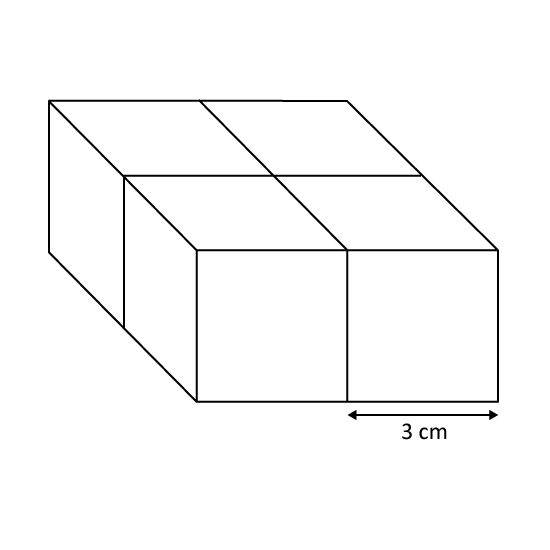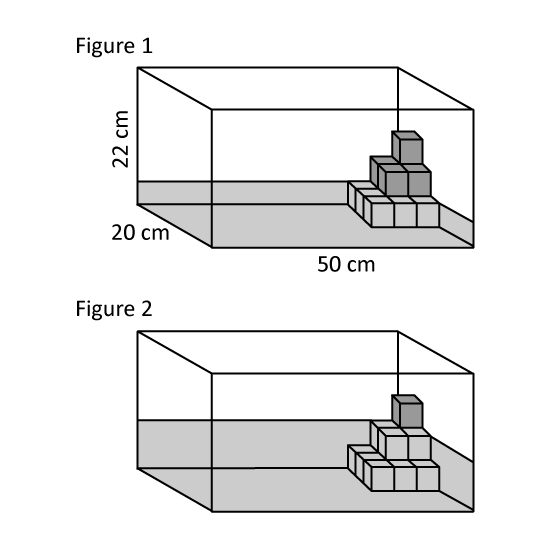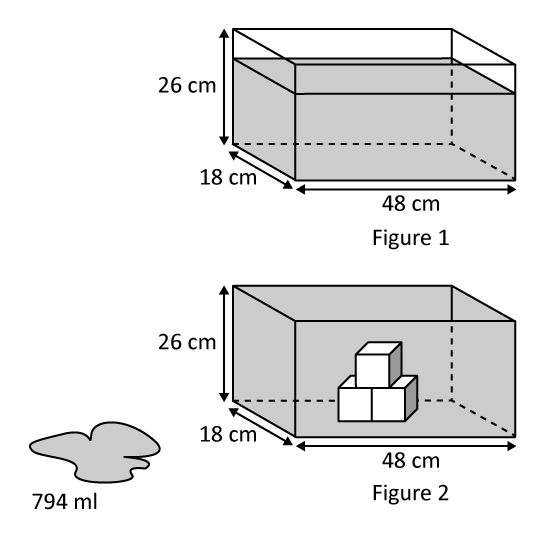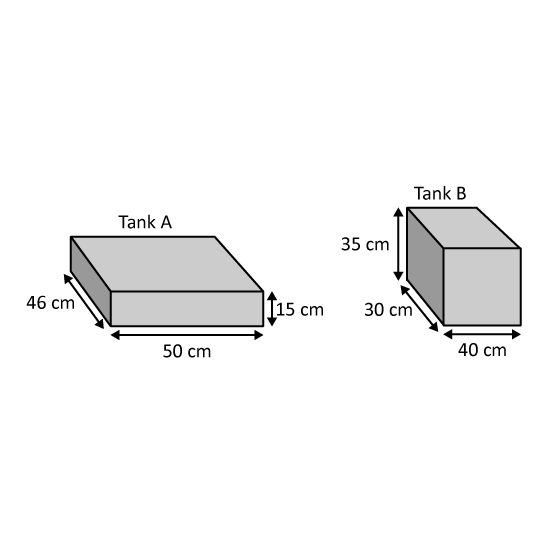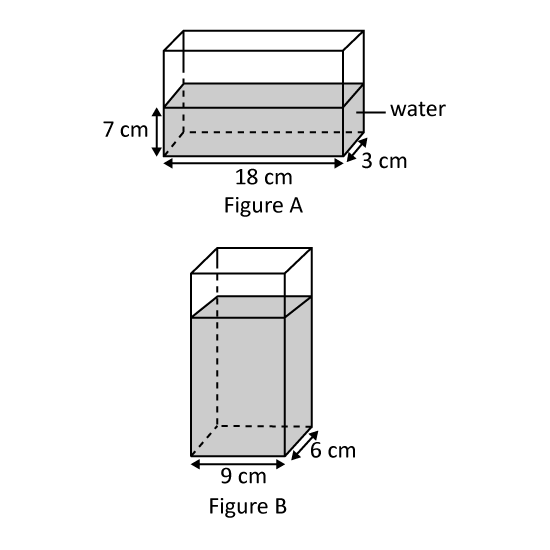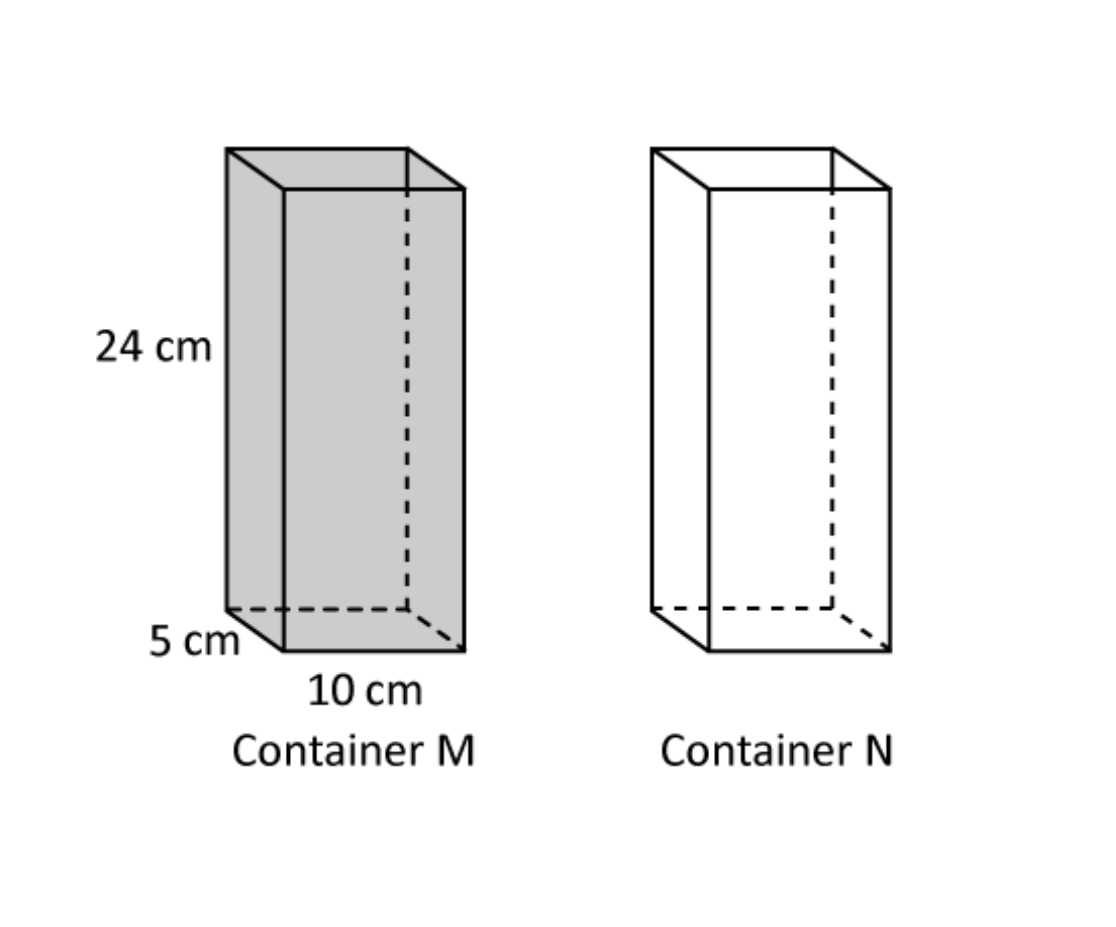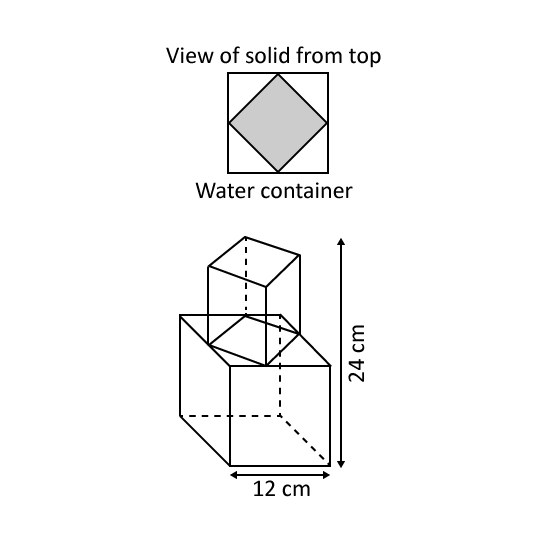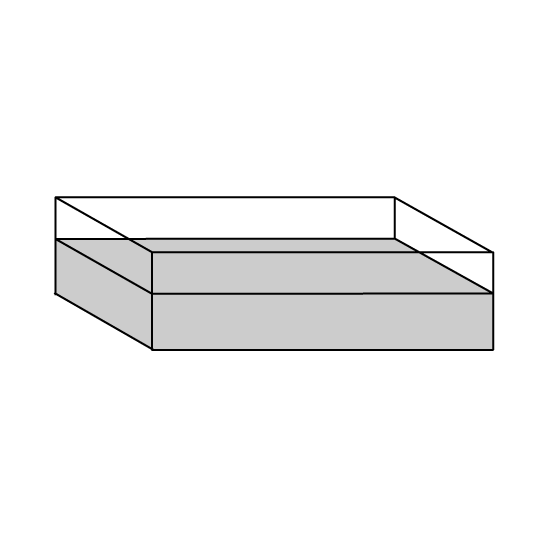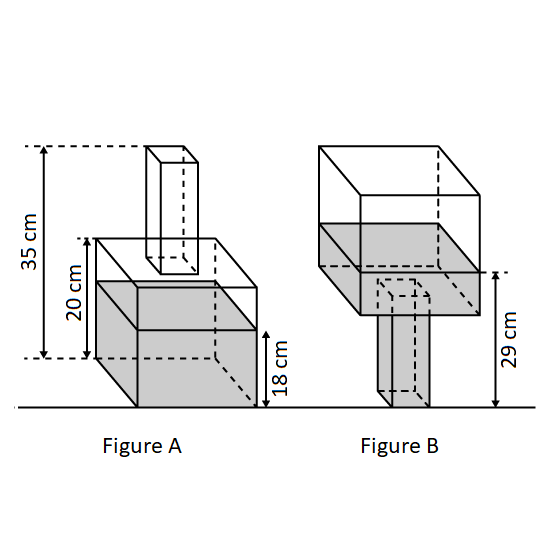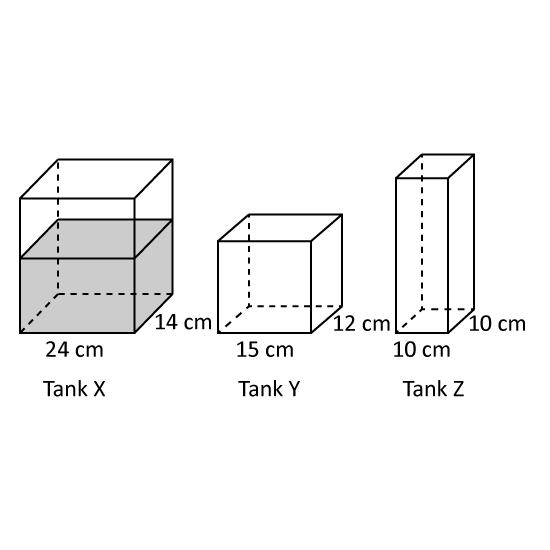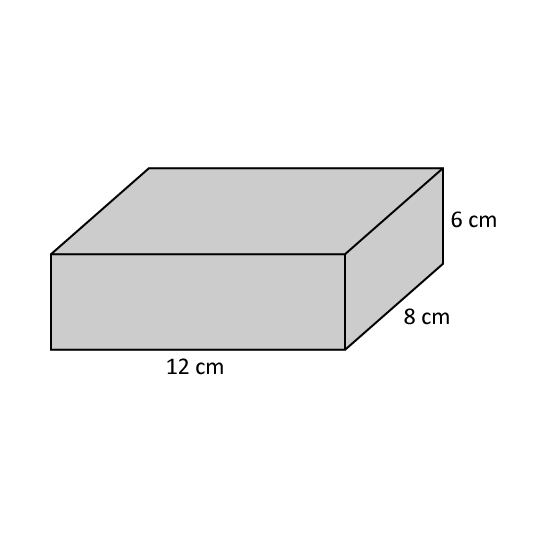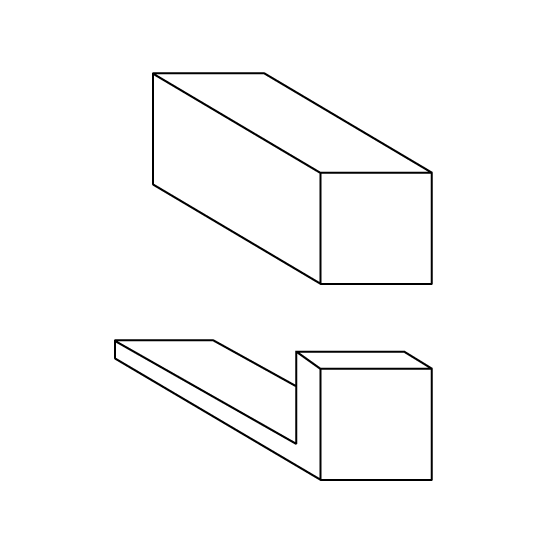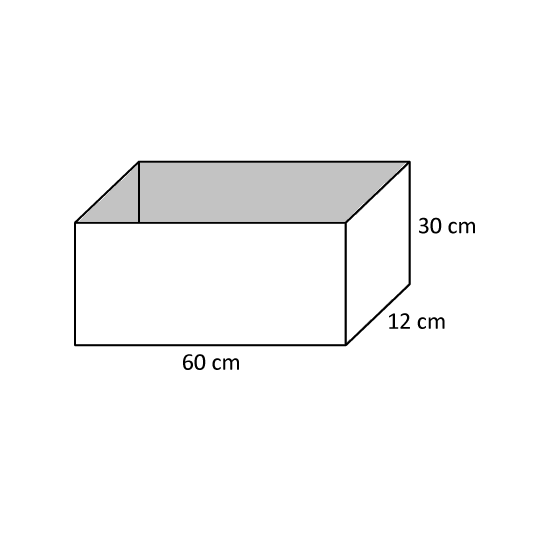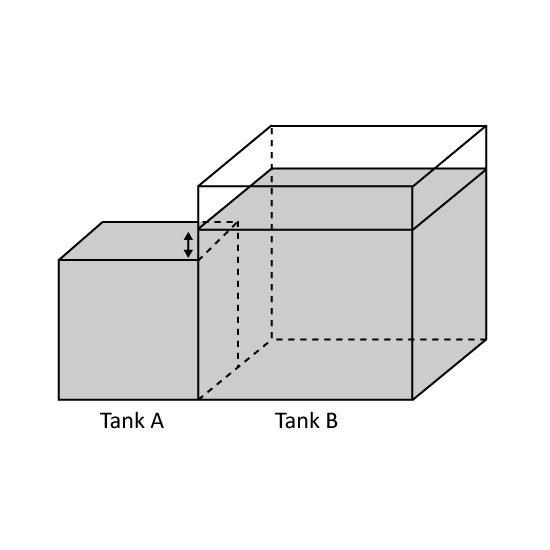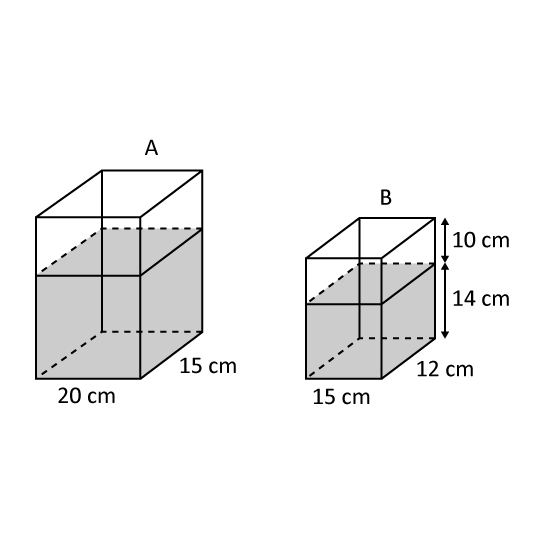Level 3 A tank was completely filled with water. The ratio of the length of the tank to its breadth to its height is 8 : 4 : 15.
- Given that the height of the tank is 45 cm, find the volume of water in the tank.
- All the water in the tank was poured into 2 empty bottles A and B without spilling any water. As a result, Bottle A had 1500 cm3 more water than Bottle B. Find the volume of water in Bottle A. Give your answer in litres.
4 m
Image in this question is not available.
Level 3
A square base tank has a volume of 2880 cm3. If the edge of the base is 35 that of its height, find the area of its base.
4 m
Image in this question is not available.
Level 3
Alan has 24 cubes of edge 3 cm. He uses all the cubes to make a cuboid that has a square base as shown.
- What is the height of the cuboid?
- If he wants to build a big cube of side 12 cm, how many more 3-cm cubes will he need?
Level 3
Alan has 24 cubes of edge 3 cm. He uses all the cubes to make a cuboid that has a square base as shown.
- What is the height of the cuboid?
- If he wants to build a big cube of side 12 cm, how many more 3-cm cubes will he need?
Image in this question is not available.
Level 3
A tank measuring 50 cm by 20 cm by 22 cm, with some cubes placed inside, was filled with 3.875 ℓ of water to the height as shown in Figure 1. Some water was then added into the tank to the height as shown in Figure 2. The total volume of water in the tank then became 8.375 ℓ. What was the volume of one cube?
Level 3
A tank measuring 50 cm by 20 cm by 22 cm, with some cubes placed inside, was filled with 3.875 ℓ of water to the height as shown in Figure 1. Some water was then added into the tank to the height as shown in Figure 2. The total volume of water in the tank then became 8.375 ℓ. What was the volume of one cube?
Image in this question is not available.
Level 3
A rectangular tank measuring 48 cm by 18 cm by 26 cm was filled with 18.8 litres of water as shown in Figure 1. When three identical wooden blocks were put into the tank, 794 mℓ of water overflowed from the tank as shown in Figure 2. Find the volume of one such wooden block.
Level 3
A rectangular tank measuring 48 cm by 18 cm by 26 cm was filled with 18.8 litres of water as shown in Figure 1. When three identical wooden blocks were put into the tank, 794 mℓ of water overflowed from the tank as shown in Figure 2. Find the volume of one such wooden block.
Image in this question is not available.
Level 3
Tank A measuring 50 cm by 46 cm by 15 cm contained 34 ℓ of water. Tank B measuring 40 cm by 30 cm by 35 cm contained 18 ℓ of water. Alan poured some water from Tank A into Tank B without spilling and the water level of Tank B rose to 28 cm. What was the height of water level left in Tank A?
Level 3
Tank A measuring 50 cm by 46 cm by 15 cm contained 34 ℓ of water. Tank B measuring 40 cm by 30 cm by 35 cm contained 18 ℓ of water. Alan poured some water from Tank A into Tank B without spilling and the water level of Tank B rose to 28 cm. What was the height of water level left in Tank A?
Image in this question is not available.
Level 3
Figure A shows a rectangular container. It is
35 filled with water. The length of the container is 18 cm and its breadth is 3 cm.
- Find the capacity of the container in litres.
- All the water in the rectangular container is poured into another tank as shown in Figure B. Find the height that represents the water level of the amount of water in it.
Level 3
Figure A shows a rectangular container. It is
35 filled with water. The length of the container is 18 cm and its breadth is 3 cm.
- Find the capacity of the container in litres.
- All the water in the rectangular container is poured into another tank as shown in Figure B. Find the height that represents the water level of the amount of water in it.
Image in this question is not available.
Level 3
Container M and Container N are identical. Container M is filled with water to the brim and Container N is empty. Some water from Container M is poured into Container N such that the ratio of the volume of water remained in Container M to that in Container N is 3 : 2.
- How much water is poured into Container N?
- Find the height of water that remained in Container M.
Level 3
Container M and Container N are identical. Container M is filled with water to the brim and Container N is empty. Some water from Container M is poured into Container N such that the ratio of the volume of water remained in Container M to that in Container N is 3 : 2.
- How much water is poured into Container N?
- Find the height of water that remained in Container M.
Image in this question is not available.
Level 3
The figure, not drawn to scale, shows an empty water container made out of 2 different solid shapes. The total height of the figure is 24 cm. The bottom part of the figure is formed by a 12-cm cube. The top part of the figure is formed by a cuboid with the corners of its square base touching the midpoints of the edges of the cube. The figure on the right shows the view of the solid from the top. 2 litres of water is poured into the empty water container. Find the height of the water level from the base of the water container.
Level 3
The figure, not drawn to scale, shows an empty water container made out of 2 different solid shapes. The total height of the figure is 24 cm. The bottom part of the figure is formed by a 12-cm cube. The top part of the figure is formed by a cuboid with the corners of its square base touching the midpoints of the edges of the cube. The figure on the right shows the view of the solid from the top. 2 litres of water is poured into the empty water container. Find the height of the water level from the base of the water container.
Image in this question is not available.
Level 3
A rectangular tank 38 cm long, 23 cm wide and 18 cm high is 45 full of water. When 14 of the water was removed from the tank, how many ℓ of water was left in the tank? Express your answer as a decimal correct to 2 decimal places.
Level 3
A rectangular tank 38 cm long, 23 cm wide and 18 cm high is 45 full of water. When 14 of the water was removed from the tank, how many ℓ of water was left in the tank? Express your answer as a decimal correct to 2 decimal places.
Image in this question is not available.
Level 3
A rectangular tank measuring 25 cm by 12 cm by 10 cm is 25 filled with water. All the water is then poured into a cubical tank with a side measuring 14 cm. How much more water is needed to fill the cubical tank completely? Give your answer in litres.
4 m
Image in this question is not available.
Level 3
A rectangular container 40 cm long, 30 cm wide and 25 cm high is
45 filled with water. When some of the water is poured into an empty rectangular glass tank until it is completely full, 4 ℓ of water is left in the container.
- How many litres of water was there in the container at first?
- What is the height of the glass tank if it is 50 cm long and 25 cm wide?
4 m
Image in this question is not available.
Level 3
The figure shows a sealed bottle of height 35 cm. It is made from two containers. The top container is in the form of a cuboid with a square base. The bottom container is in the form of a cube of side 20cm. The height of the water in the bottle (shown in Figure A) is 18 cm.
When the same bottle is turned upside down (shown in Figure B), the height of the water in the bottle is 29 cm. How much water can the sealed bottle hold if it is completely filled?
Level 3
The figure shows a sealed bottle of height 35 cm. It is made from two containers. The top container is in the form of a cuboid with a square base. The bottom container is in the form of a cube of side 20cm. The height of the water in the bottle (shown in Figure A) is 18 cm.
When the same bottle is turned upside down (shown in Figure B), the height of the water in the bottle is 29 cm. How much water can the sealed bottle hold if it is completely filled?
Image in this question is not available.
Level 3
Container A and B are identical containers with the same base area and height. Container A is filled to the brim with water while Container B is empty. After 240 cm3 of water is poured into Container B from Container A, the depth of water in Container B is 14 the depth of water in Container A. If the height of the container is 25 cm, what is the base area of Container B?
4 m
Image in this question is not available.
Level 3
Tank X was filled with water with water up to a height of 11 cm while Tank Y and Z were empty. Water was poured out into Tank Y and Z such that the water in all tanks were the same height in the end. How much water was poured out of Tank X?
Level 3
Tank X was filled with water with water up to a height of 11 cm while Tank Y and Z were empty. Water was poured out into Tank Y and Z such that the water in all tanks were the same height in the end. How much water was poured out of Tank X?
Image in this question is not available.
Level 3 PSLE
Ray had a rectangular block of wood 12 cm by 8 cm by 6 cm. He painted all the faces of the block.
- What is the total painted area?
- Ray then cut the block into 1-cm cubes. How many of these cubes have none of the faces painted?
- How many of these cubes have 2 of the faces painted?
Level 3 PSLE
Ray had a rectangular block of wood 12 cm by 8 cm by 6 cm. He painted all the faces of the block.
- What is the total painted area?
- Ray then cut the block into 1-cm cubes. How many of these cubes have none of the faces painted?
- How many of these cubes have 2 of the faces painted?
Image in this question is not available.
Level 3
The figure shows a wooden cuboid that measures 125 cm by 20 cm by 20 cm.
- Find the maximum number of 3-cm cubes that can be cut from the wooden cuboid.
- Find the total surface area of the L-shaped block after cutting.
Level 3
The figure shows a wooden cuboid that measures 125 cm by 20 cm by 20 cm.
- Find the maximum number of 3-cm cubes that can be cut from the wooden cuboid.
- Find the total surface area of the L-shaped block after cutting.
Image in this question is not available.
Level 3 PSLE
An open rectangular box is shown.
- The inside of the box including the base is painted. Find the painted area.
-
When the box is packed full with 1-cm cubes, how many cubes are there?
-
How many cubes touch inside the box as a result?
Level 3 PSLE
An open rectangular box is shown.
- The inside of the box including the base is painted. Find the painted area.
-
When the box is packed full with 1-cm cubes, how many cubes are there?
-
How many cubes touch inside the box as a result?
Image in this question is not available.
Level 3
The figure is not drawn to scale. It shows a container made of two connected cubical tanks, A and B. Tank A is sealed at the top and completely filled to the brim. Tank B is
35 filled with 129600 mℓ of water. The height of the water level in Tank B is 1 cm higher than that in Tank A. The height of Tank B is 60 cm. Water is then drained from the container and the height of the water level from the base falls to 30 cm.
- What is the capacity of Tank B?
-
What is the volume of water in the tank now in litres?
Level 3
The figure is not drawn to scale. It shows a container made of two connected cubical tanks, A and B. Tank A is sealed at the top and completely filled to the brim. Tank B is
35 filled with 129600 mℓ of water. The height of the water level in Tank B is 1 cm higher than that in Tank A. The height of Tank B is 60 cm. Water is then drained from the container and the height of the water level from the base falls to 30 cm.
- What is the capacity of Tank B?
-
What is the volume of water in the tank now in litres?
Image in this question is not available.
Level 3 PSLE The figure shows the amount of water in two rectangular Tanks, A and B, at first.
Ray poured
14 of the water from A into B to fill it to the top, without overflowing.
- How much water was there in A at first?
- Ray then poured all the water from B into A. 720 cm3 of water overflowed from A. What was the height of A?
Level 3 PSLE The figure shows the amount of water in two rectangular Tanks, A and B, at first.
Ray poured
14 of the water from A into B to fill it to the top, without overflowing.
- How much water was there in A at first?
- Ray then poured all the water from B into A. 720 cm3 of water overflowed from A. What was the height of A?
Image in this question is not available.
